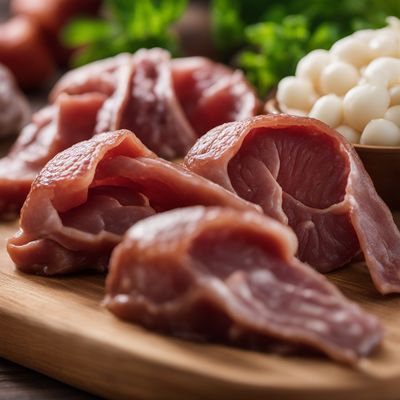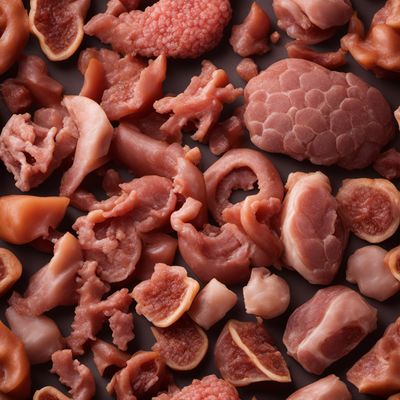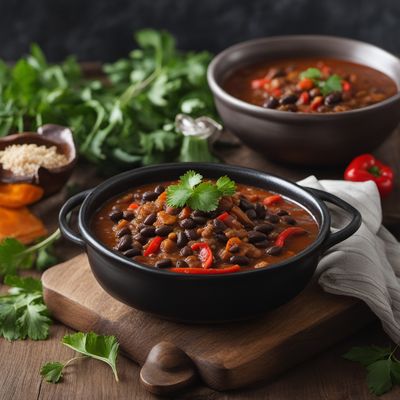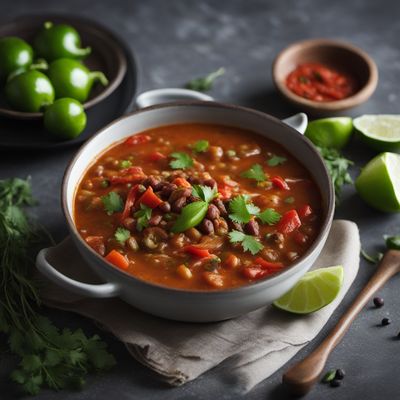
Ingredient
Sheep edible offal, non-muscle, other than liver and kidney
Exploring the Delicacies of Sheep Edible Offal
Sheep edible offal, non-muscle, other than liver and kidney, encompasses a variety of organ meats such as heart, lungs, spleen, and tripe. These offal cuts are known for their robust flavors and tender textures. They can range from mild and delicate to rich and gamey, depending on the specific organ. When cooked properly, they become melt-in-your-mouth tender and add a distinct character to dishes.
Origins and history
Sheep edible offal has a long history of consumption in many cultures around the world. It has been a staple in traditional dishes, particularly in Mediterranean, Middle Eastern, and African cuisines. These offal cuts were highly valued for their nutritional content and were often utilized to minimize food waste.
Nutritional information
Sheep edible offal is a good source of protein, vitamins, and minerals. It is particularly rich in iron, zinc, and vitamin B12. However, it is important to note that offal cuts can be high in cholesterol and should be consumed in moderation as part of a balanced diet.
Allergens
May contain traces of allergens such as gluten or sulfites.
How to select
When selecting sheep edible offal, look for cuts that are fresh, firm, and free from any unpleasant odors. The color should be vibrant and uniform, without any discoloration or signs of spoilage. If purchasing from a butcher, ensure that the offal is sourced from a reputable supplier and handled with proper hygiene practices.
Storage recommendations
To maintain the freshness of sheep edible offal, store it in the refrigerator at a temperature below 40°F (4°C). It is best to use the offal within a few days of purchase to ensure optimal flavor and quality. If not consumed immediately, it can be frozen for longer storage. Proper packaging in airtight containers or freezer bags will help prevent freezer burn and maintain the offal's texture and taste.
How to produce
Sheep edible offal is typically produced as a byproduct of sheep farming. To produce high-quality offal, it is essential to raise healthy sheep in a clean and well-maintained environment. Proper feeding and veterinary care are crucial to ensure the safety and quality of the offal cuts.
Preparation tips
Sheep edible offal can be prepared in various ways, depending on the specific cut. Heart and liver can be grilled, pan-fried, or braised for a rich and flavorful dish. Lungs and spleen are often used in stews or soups, adding a unique texture and depth of flavor. Tripe can be simmered for an extended period to achieve tenderness and is commonly used in traditional dishes such as tripe soup or stew. It is important to thoroughly clean and prepare the offal before cooking to remove any excess fat or membranes.
Culinary uses
Sheep edible offal, excluding the liver and kidney, is commonly used in a variety of dishes around the world. It can be incorporated into stews, pies, sausages, or even grilled for a hearty and flavorful meal. In Mediterranean cuisine, offal cuts are often featured in traditional dishes such as haggis, menudo, or kokoretsi.
Availability
Mediterranean region, Middle East, Africa
More ingredients from this category

Wild boar edible offal, non-muscle, other than liver and kidney
Savory Treasures from the Wild

Pig edible offal, non-muscle, other than liver and kidney
Beyond the Ordinary: Exploring the Versatility of Pig Edible Offal

Equine edible offal, non-muscle, other than liver and kidney
Exploring the Hidden Gems of Equine Edible Offal

Bovine edible offal, non-muscle, other than liver and kidney
The Hidden Gems of Bovine Offal

Deer edible offal, non-muscle, other than liver and kidney
The Hidden Gems of Deer: Exploring Non-Muscle Edible Offal

Goat edible offal, non-muscle, other than liver and kidney
The Hidden Gems of Goat: Exploring the Delicacies of Edible Offal

Rabbit edible offal, non-muscle, other than liver and kidney
Unveiling the Hidden Gems: Exploring the Versatile Rabbit Edible Offal

Camel edible offal, non-muscle, other than liver and kidney
Unveiling the Hidden Gems: Exploring the Exquisite Camel Edible Offal
Recipes using Sheep edible offal, non-muscle, other than liver and kidney

Asturian Schwarzer Magister
Asturian Black Magister: A Savory Delight from the Asturian Countryside

Sami-style Sweet Bean Strudel
Arctic Delight: Sami-style Sweet Bean Strudel

Haitian Black Bean Stew
Savory Delight: Haitian Black Bean Stew

Chinese Imperial Calentado
Imperial Harmony: A Fusion of Colombian Calentado and Chinese Imperial Cuisine

Mexican-style Fava Bean and Fennel Stew
Savory Mexican Fava Fiesta